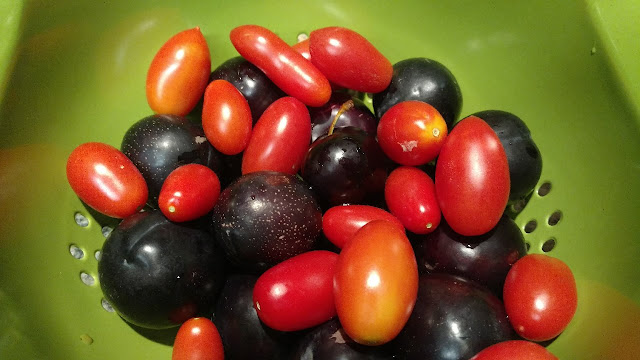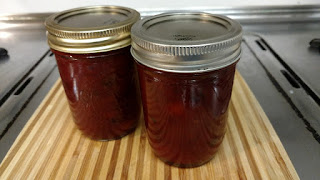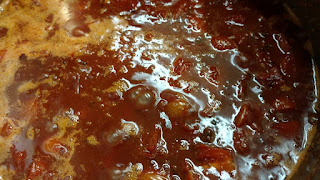
Recipe: Plum-plum tomato chutney like a chunky ketchup
 |
| Dark plums and ripe plum tomatoes combine in a summery chutney. (Photos: Debbie Arrington) |
An overload of Juliet tomatoes and a big basket of purple plums inspired this recipe.
After I made several batches of plum jam and tomato sauce, it was time to move on to something that combines the sweet with the savory: Chutney.
This version is nothing like commercial, vaguely Indian chutneys. My tomato-based chutney tastes more like an upscale chunky ketchup with a pleasant balance of sweet and tart. It’s a tasty relish on burgers, hot dogs or sandwiches as well as an accompaniment to pork chops or tenderloin. It works with French fries, too.
Meatier in texture, plum tomatoes cook down faster than their round counterparts, so I like to use them in chutneys, which thicken on the stove. (And it makes for a fun recipe name.)
This recipe can scale up or down, depending on how many tomatoes and plums you have sitting on the counter.

|
Plum-plum tomato chutney
Makes 4 cups
Ingredients:
 |
| Chutney simmers for up to an hour or more. |
Comments
0 comments have been posted.Sacramento Digs Gardening to your inbox.
Sites We Like
Garden Checklist for week of April 21
This week there’s plenty to keep gardeners busy. With no rain in the immediate forecast, remember to irrigate any new transplants.
* Weed, weed, weed! Get them before they flower and go to seed.
* April is the last chance to plant citrus trees such as dwarf orange, lemon and kumquat. These trees also look good in landscaping and provide fresh fruit in winter.
* Smell orange blossoms? Feed citrus trees with a low dose of balanced fertilizer (such as 10-10-10) during bloom to help set fruit. Keep an eye out for ants.
* Apply slow-release fertilizer to the lawn.
* Thoroughly clean debris from the bottom of outdoor ponds or fountains.
* Spring brings a flush of rapid growth, and that means your garden is really hungry. Feed shrubs and trees with a slow-release fertilizer. Or mulch with a 1-inch layer of compost.
* Azaleas and camellias looking a little yellow? If leaves are turning yellow between the veins, give them a boost with chelated iron.
* Trim dead flowers but not leaves from spring-flowering bulbs such as daffodils and tulips. Those leaves gather energy to create next year's flowers. Also, give the bulbs a fertilizer boost after bloom.
* Pinch chrysanthemums back to 12 inches for fall flowers. Cut old stems to the ground.
* Mulch around plants to conserve moisture and control weeds.
* From seed, plant beans, beets, cantaloupes, carrots, corn, cucumbers, melons, radishes and squash.
* Plant onion sets.
* In the flower garden, plant seeds for asters, cosmos, celosia, marigolds, salvia, sunflowers and zinnias.
* Transplant petunias, zinnias, geraniums and other summer bloomers.
* Plant perennials and dahlia tubers for summer bloom.
* Mid to late April is about the last chance to plant summer bulbs, such as gladiolus and tuberous begonias.
* Transplant lettuce seedlings. Choose varieties that mature quickly such as loose leaf.